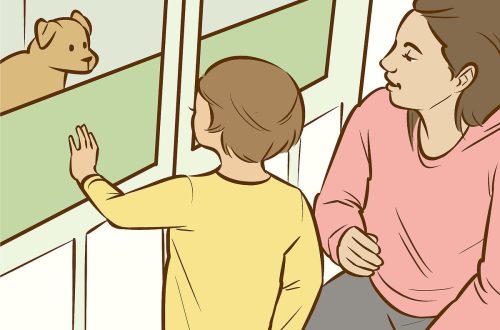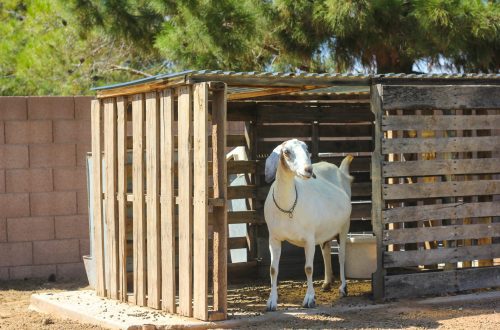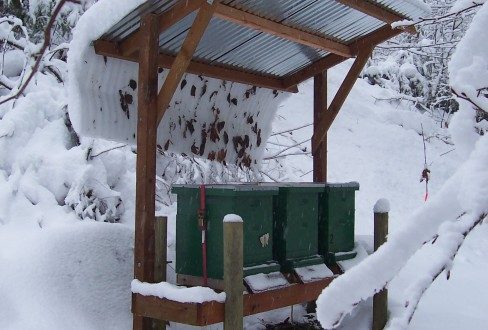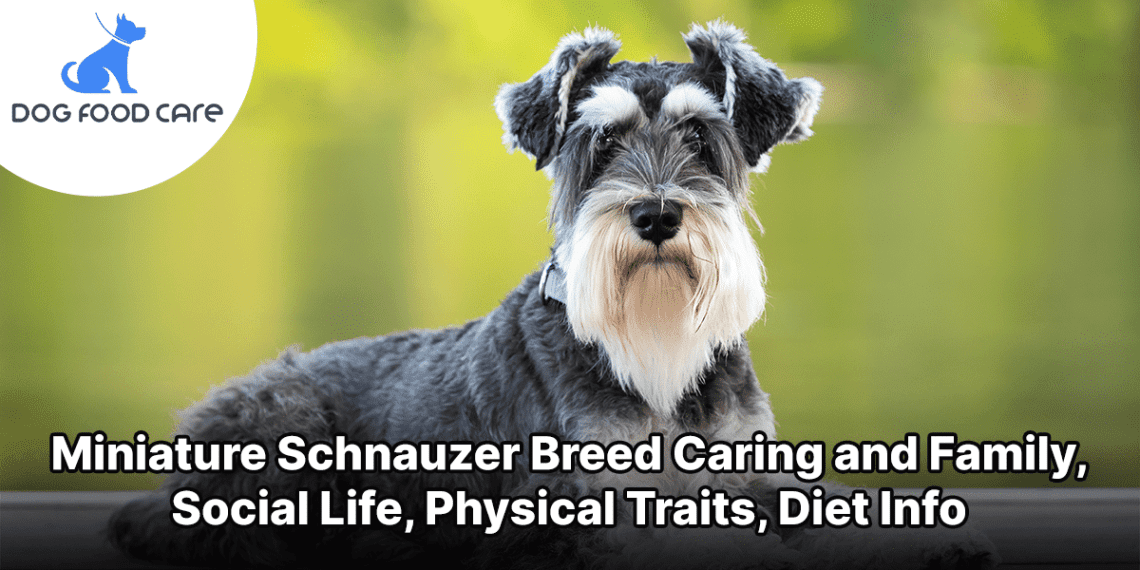
Miniature Schnauzer – breed characteristics, trimming features, how to choose what to feed, owner reviews, dog photos
The Miniature Schnauzer or Miniature Schnauzer is one of the most popular dogs in the world. This is understandable, because it is easy to maintain and has excellent characteristics. The breed is characterized by such qualities as prudence, intelligence, energy, attentiveness and courage. All this makes the miniature schnauzer an excellent watchman and true friend.
Contents
- Historical information about miniature schnauzer
- Characteristics of the breed
- How to choose a puppy
- Pet Care
- Features of the content in the apartment
- Hygiene
- Trimming and grooming
- Video: trimming a schnauzer
- Video: Schnauzer paw trim example
- Video: master class on working as a furminator
- Photo gallery: Schnauzer care products
- Principles of proper nutrition
- Features of mating, the course of pregnancy and childbirth
- Raising and training a miniature schnauzer
- Pet health
- Nickname choice
- Owner feedback
Historical information about miniature schnauzer
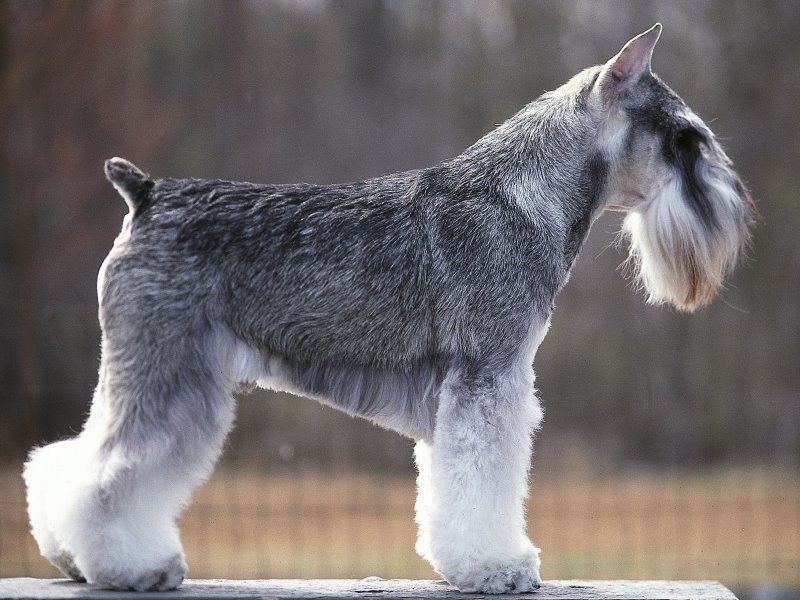
Miniature Schnauzer is a breed of German origin.
The Miniature Schnauzer is the smallest service breed in the world. By origin, it belongs to the group of pinschers, being their wire-haired subspecies. The historical homeland is Germany, where pets were originally used to catch rats and other pests.
As you know, in the breed range of schnauzers there are three subspecies: rizen, mittel and zwerg (from the largest to the smallest, respectively). The miniature schnauzer first appeared in the 30th century. To achieve excellent breed qualities, temperament and appearance, breeders had to spend a lot of time and effort. To get a height of 35–XNUMX cm, German Spitz, Affenpinschers, Poodles, Miniature Pinschers, and also Burrow Wirehaired Terriers were involved in breeding work. Interbreed matings were carried out under strict control until the desired size of the dog was reached. However, a side effect was the color, uncharacteristic of the breed group. Why breeders began to “cull” unsuitable puppies in color, excluding them from the breeding chain.
As a result, pets acquired ideal security qualities, a suitable appearance and an outstanding mind.
The first miniature schnauzer was presented at a dog show in Germany in 1890, making a splash.. The official standard was recognized at the same time. The breed quickly gained popularity among breeders. Miniature security guards began to be actively supplied to the countries of Scandinavia, Canada, Austria and the USA. The first miniature schnauzers came to the territory of the USSR thanks to the American Fritz Tinker in 1974, when he brought with him two female puppies and one male. Moscow kennels have been actively breeding dogs since 1980. Today, the breed is one of the most popular in the watchdog group.
Characteristics of the breed
The miniature schnauzer is a miniature copy of the standard schnauzer, completely retaining the features of the exterior, physique, and performance. But if you decide to get yourself such a pet, you should know all the subtleties of the standards, as well as the behavior of the animal.
FCI standard
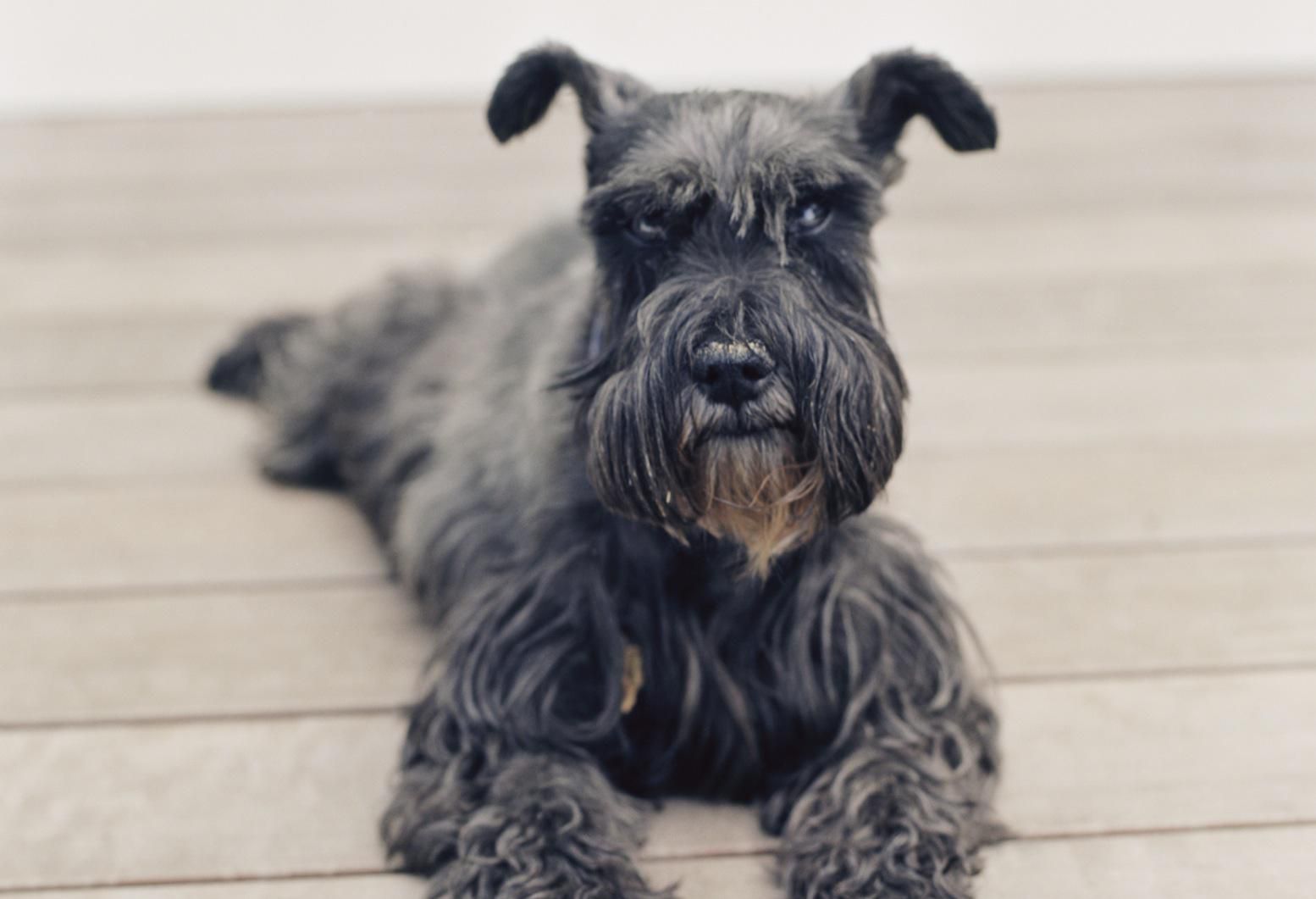
The miniature schnauzer is the smallest species of the line of all schnauzers
Height at the withers for a male is 35 cm, for females – 30 cm. Weight varies between 4,5–7 kg, respectively. The body is proportional. The withers are clearly defined, high with a smooth bending line towards the tail. The loin and back are short. The ribs are well sprung, the chest is deep, moderately broad. The croup has a slight rounding, the stomach is tucked up.
The head of the zwerg has a clear rectangular shape with elongation. The skull is flat, the transition to the muzzle is slightly noticeable. The jaws are strong, the cheekbones are flat. Eyebrow protrusions are pronounced. The nose is large. The eyes are brown. The ears are set high. According to the breed standard, they can be either sharply docked (standing) or hanging in their natural state. The neck is strong, of medium length, dry with a beautiful bend.
The limbs are strong. The front ones are straight, while the back ones have clearly defined hock and knee angulations. Paws are rounded with strong pads and clenched toes. The shoulder blades are long, obliquely set. The pasterns are slightly inclined. The elbows are pressed to the body. The hind legs are somewhat longer than the front.
Coat type and colors of miniature schnauzer
The coat of the Miniature Schnauzer consists of a dense, straight, coarse long guard hair and a short but dense undercoat. However, the beard, mustache, eyebrows, lower curve of the abdomen and limbs are decorated with softer long hair. Four types of color are recognized by the standard:
- black with silver;
- “pepper and salt”;
- white;
- black;
The first two types are considered the most popular.. “Pepper and salt” or also called zoned gray is a mixed color with a uniform gray undercoat and the presence of a dark mask on the muzzle, enhancing the expression typical of the breed.
Black and Silver Miniatures may have distinct white markings, such as the throat, eyebrows, chin, chest or muzzle. In this case, the gray color is completely excluded.
Important! The mark on the chest can only be in the form of an hourglass lying on its side. A disproportionate shape is recognized as a disadvantage.
White color is one of the rarest, but allowed by the breed standard. The Black Miniature Schnauzer is more common, but the rules require that the color be pure, including pigmentation of the nose, paw pads, and skin.
Important! You can meet the miniature schnauzer of chocolate and tan color. However, this color is not recognized by the FCI standard and is considered a marriage.
Photo gallery: differences in breed color
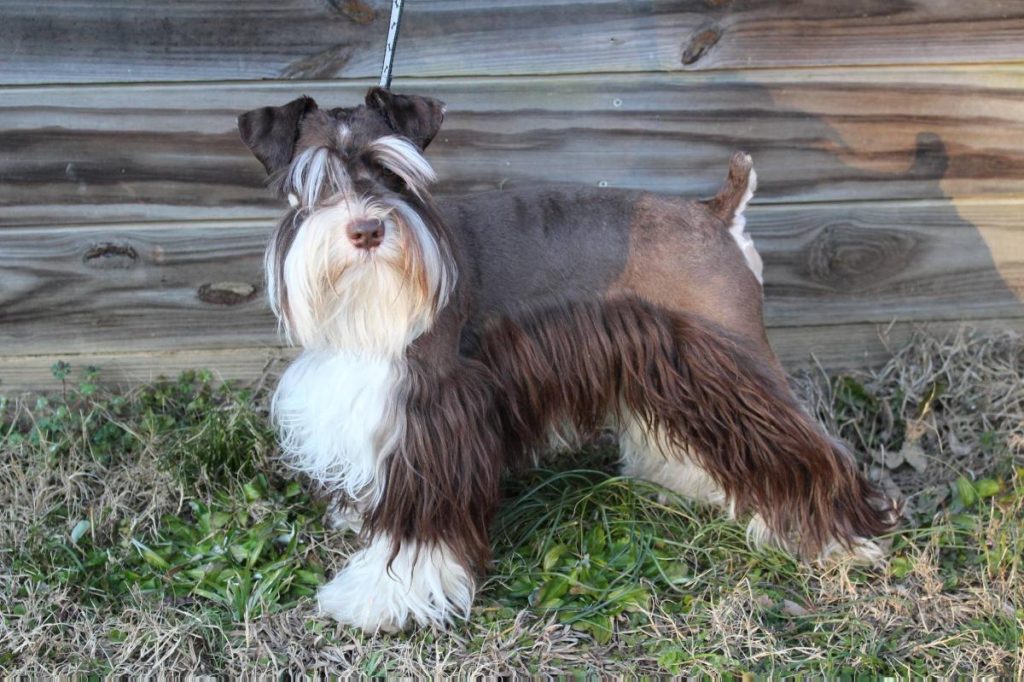
Tan is not recognized by the FCI standard.

White color is one of the rarest

“Pepper and salt” – the classic color of the schnauzer
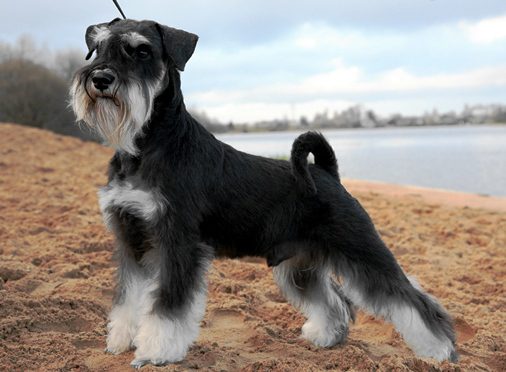
Black and silver color – one of the most popular
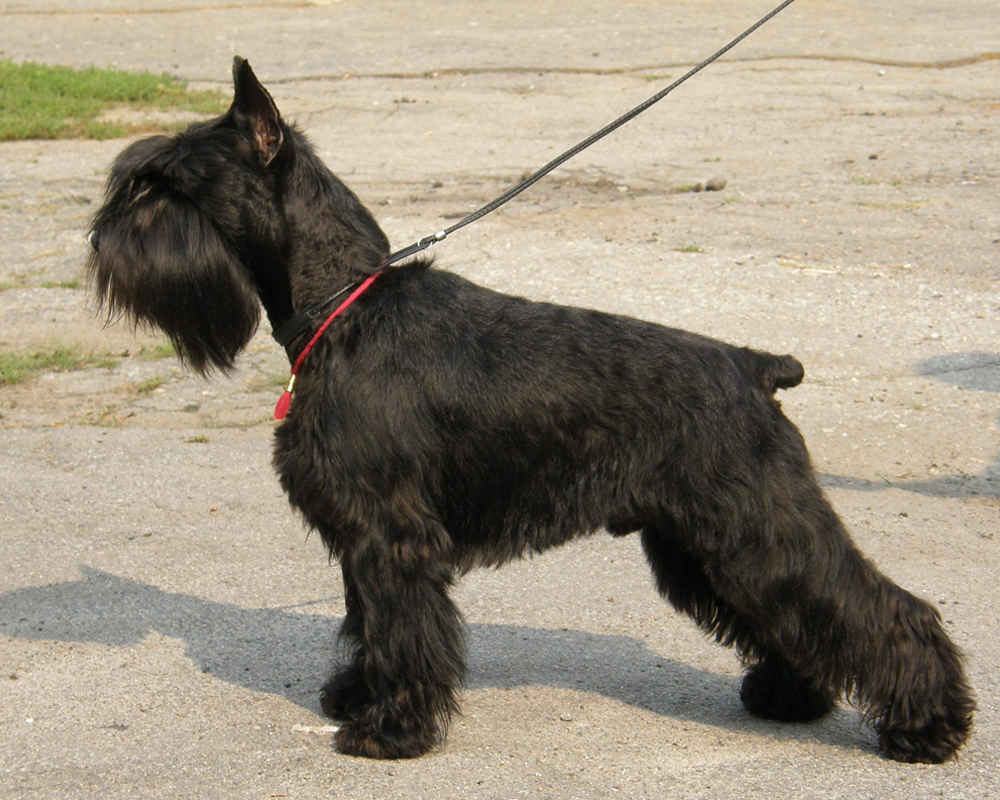
Black color does not allow light markings at all
The nature and working qualities of the dog
Wits, energy, fearlessness and vigilance are the hallmarks of this breed. Inside the miniature schnauzer lies the spirit of a large and bold dog. The pet is able to independently assess the current situation and make a decision, which is a mandatory characteristic of a guard dog.
Important! An interesting feature, noticed by many dog breeders, is that often the color of the zwerg determines its character.
Black is a miniature Risen. Such a pet is hardy, balanced, ready to work under any conditions and instantly switch from one task to another. They are loyal to one owner and fearless.
The classic color “pepper and salt” in many ways conveys the character of the middle mitel. This is an assertive, energetic dog with a pronounced hunting instinct and a desire for independence. Such a zwerg is unlikely to be indifferent to rodents, but he is a good companion and “nanny” for children.
An elegant miniature schnauzer of black and silver color is more decorative and excitable. Most often, he has a soft, docile character, is faithful to all family members, and especially treats small household members well. Such a dog is friendly, but vigilant and will not give offense.
White zwergschnauzers often show independence, they are pretentious and easily excitable. Dog breeders note a tendency to food allergies. However, these pets are quick-witted and smart. But chocolate and tan are distinguished by surprisingly good health, energy and a cheerful attitude. They like to catch rats and need attention.
The general characteristics of all zwerg dogs boil down to the fact that these dogs are extremely smart, loyal and well trained. They are good-natured and playful, enthusiastically greet guests, but at the same time they are able to instantly catch the aggressive mood of the ill-wisher and rush to protect the owner.
The Miniature Schnauzer is a great companion. He loves walks and needs active play in nature. Most of all, these little funny pets love to participate in family affairs.
Important! Dogs of this breed require a lot of attention and are not suitable for owners who constantly do not have enough time to communicate with the pet.
In relation to other animals, the miniature schnauer is usually neutral. He can chase a cat, but only while playing. However, dog breeders note that such a pet can be cocky towards relatives of the same sex.
Video: breed overview
How to choose a puppy
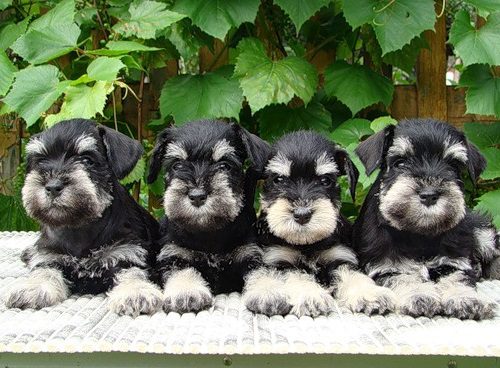
The choice of a puppy is best done in a breeding kennel
If you decide to get a miniature schnauzer, then it is best to contact a specialized nursery. The purchase will cost you an average of 300 to 600 dollars (depending on the rarity of the color and pedigree). Do not be too lazy to visit several breed shows, where you can clearly see the differences between pets and ask owners about the features of maintenance, care and temperament.
Check out the puppy first. Healthy babies have clear eyes, glossy shiny coat, they are moderately well-fed and have a good appetite. These puppies are active and playful. The tummy of a healthy baby will be somewhat rounded, but not swollen (this may be a sign of worms). Wool should not have bald spots. Hair that is too long or short, as well as curly, shaggy, indicates a non-purebred mating. The undercoat should be dense, no longer than the top coat.
Vices that you can immediately identify:
- light eye color (they should only be brown);
- short jaw, malocclusion;
- twisted limbs;
- sloping croup;
- narrow or short muzzle;
- lack of a lock (when the puppy’s fangs rest directly on the palate);
- lack of incisors (each jaw should have 6 pieces);
- males should have 2 testicles of the same size.
Remember that some owners are only interested in profit. If you do not have the opportunity to invite a specialist to help you make a choice, take the so-called “Litter Survey Act” from the breeder to find out which puppies were rejected by the commission. If the number of excluded babies reaches half, then it is not recommended to take a dog. Also ask how many puppies were in the litter. The number of more than 6-8 should alert. You should not take a baby if the bitch was bred less than a year ago. Frequent childbirth leads to the depletion of the animal and the weakening of the offspring.
If you have the opportunity to choose a dog from the entire litter, be sure to compare the puppies with each other. Give preference to a baby with a proportional body, a rectangular head and the above characteristics of a healthy dog.
Video: an example of puppy behavior
And finally, color. According to the standard, with a black color of a miniature schnauzer, light spots, a brownish tint or a gray undercoat are not allowed (this is considered a breeding marriage). However, please note that at the age of 3-6 months, these dogs may experience temporary “graying”, when singly white hairs appear all over the body. This is not considered a marriage and after a couple of plucking procedures, the effect disappears.
Black and Silver Miniature Schnauzers must be pure with silver tan and mask. It is worth paying attention to some points. Before the age of 2 months, it is sometimes difficult to determine whether the color will be exclusively black. However, you can determine what shade the silver coat will be – light or dark. Give preference to the first option.
Important! In a black and silver zwerg, the final color can be formed up to two years of age. The brown undercoat and bangs are plucked out, after which a clear mask will appear.
Puppies of the classic color “pepper and salt” initially have a dark color with a mask. But it is undesirable when such a baby has a brown or red shade of the outer hair, because this can be a defect. Also, the presence of a dark stripe on the back is not welcome. The undercoat should be a light gray tone. White spots on the chest, chin and between the fingers later disappear.
White miniature schnauzers should not have cream spots. The rims of the eyelids, nose, lips and nails are well pigmented from an early age according to the breed standard.
The last moment is cropping of the ears and tails. Be sure to pay attention to this feature when choosing a puppy. Unscrupulous breeders sometimes play it safe and stop the risk zone if the litter previously had puppies with broken tails or loose ears. As a result, such a baby is sold as a high-bred one. By the way, the natural hanging shape of the ears and tail is prescribed by the standard, so you should not buy a deliberately “defective” pet.
Important! Cupping a dog’s ears is not a preventative measure for otitis media. Dishonest breeders often use this excuse when trying to sell a puppy with a deviance.
Pet Care
The compact size of the pet and unpretentiousness make it acceptable for living in a city apartment. But to achieve maximum comfort for the owner and the animal, attention should be paid to some nuances.
Features of the content in the apartment
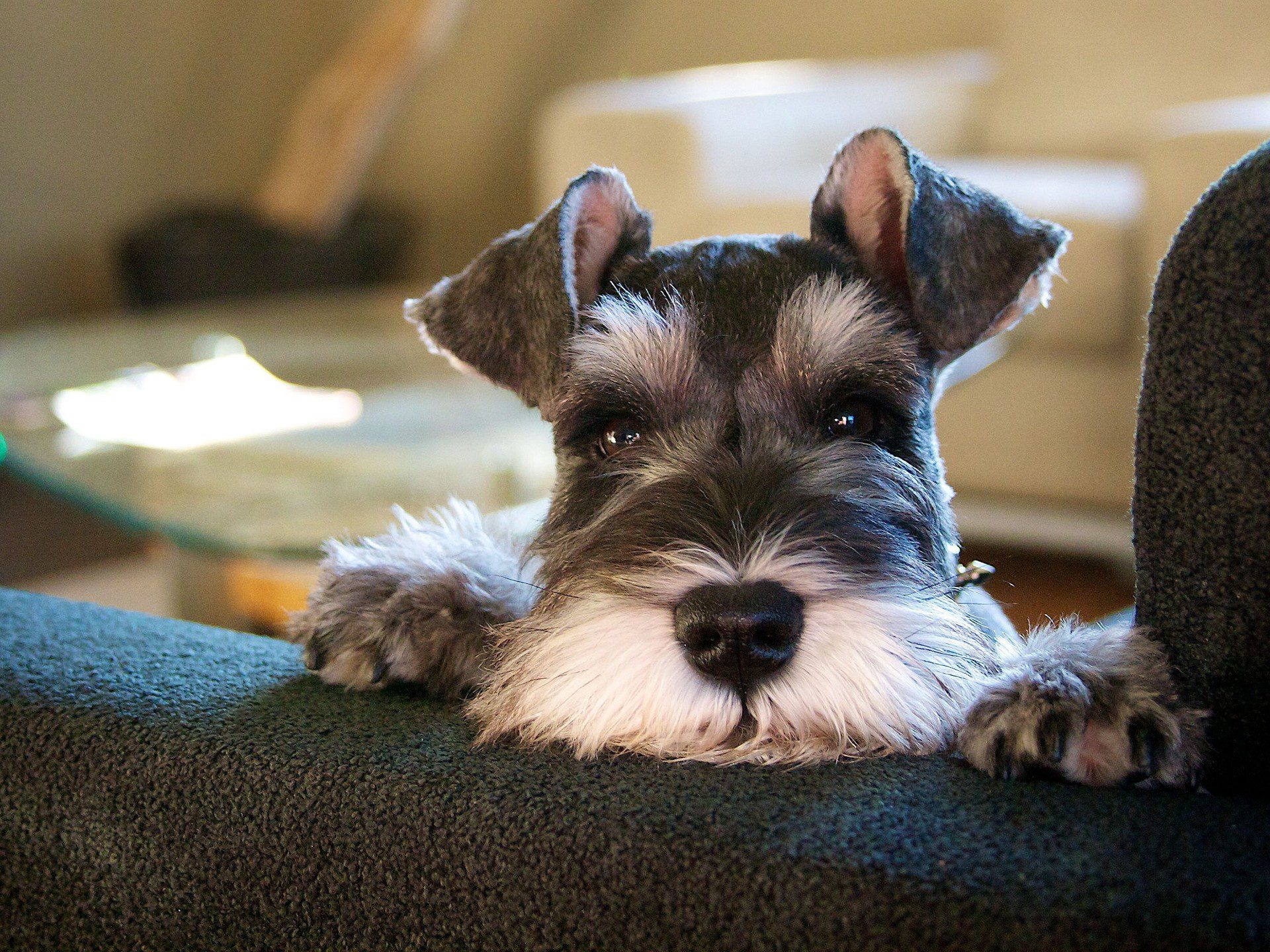
Miniature Schnauzers are ideal for keeping in an apartment.
The Miniature Schnauzer is an active dog, something to keep in mind if you are at work most of the day. The pet needs an outlet of energy, so take care of two walks a day with elements of active games. The optimal duration is 40-60 minutes.
If you do not want the dog to spoil furniture, shoes and other items of potential interest to her during your absence, pick up a toy (bone, ball, plush animal, etc.). Also take care of the place for your pet. It is best to purchase a ready-made lounger of a suitable size and place it away from heaters, as well as drafts.
Important! Remember that the zwerg are great lovers of relaxation on the master’s bed. If you do not intend to share your bed with a pet, lock the doors when leaving the apartment.
Hygiene
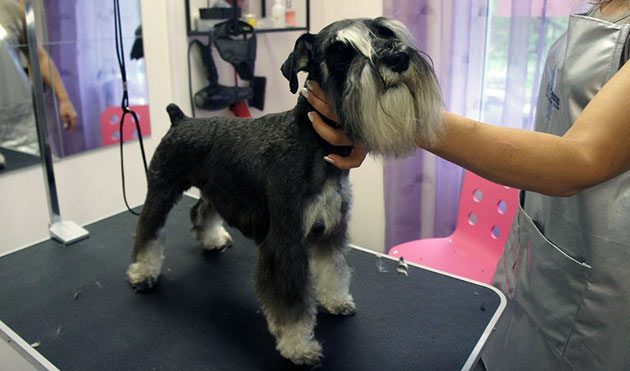
Schnauzer paws need special care
Caring for the ears of a miniature schnauzer, especially not docked, is one of the most important points. Therefore, you will need to regularly carry out the following manipulations:
- cut the hair around the ears as it grows back;
- wipe the ear canal every week with a cotton pad soaked in water;
- once a month, pluck the hairs inside the ear.
Important! If the pet shows anxiety, namely shaking his head, scratching his ears, whining, or if you notice abundant discharge from the canal, immediately show the dog to the veterinarian.
Eye care comes down to simple manipulations. It is necessary once a week to wipe the discharge in the corners with a cotton swab dipped in warm boiled water. Treat each eye with a clean disc.
Nails should be trimmed as needed. For example, in dogs that walk daily on asphalt or hard ground, they grind off by themselves. But if your pet walks mostly on grass or soft ground, he needs help. The nails are cut with a special nail cutter so as not to touch the blood vessel and nerve. It is optimal to shorten by 2-3 mm every two months.
Important! Strongly overgrown claws should not be cut immediately to a large length, as this can provoke bleeding. This procedure is carried out gradually, removing 1 mm over 2-3 weeks.
Check your dog’s paw pads regularly for cracks. As a rule, they form in the winter. If you find such microtraumas, treat the damaged area with an oil solution of vitamin A. Do not lose sight of this problem, because in winter the paths are often sprinkled with salt. Getting into the cracks on the paw pads, it corrodes the wounds and causes discomfort to the dog.
Trimming and grooming
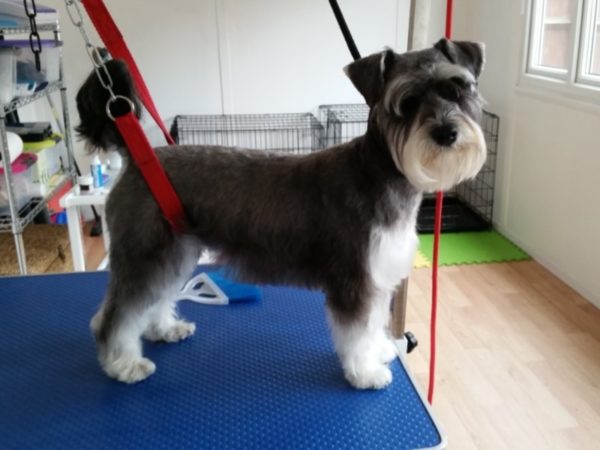
Trimming replaces miniature schnauzer molting and is essential for health
The miniature schnauzer is a breed whose coat after reaching the age of six months 2-3 times a year is subject to trimming (a special procedure for plucking the outer hair), which replaces the pet’s seasonal molt and is necessary for an aesthetic appearance.
The peculiarity of the coat of these dogs is that the process of its renewal is slowed down. Even dead hairs do not fall out on their own. Therefore, by trimming, you remove the old coat, making room for the new one.
It is completely painless for the dog.
Important! Trimming is carried out in the warm season.
Plucking is not performed throughout the body, but only on the back, part of the neck and sides. Ears, cheekbones, temples, throat, abdomen, genital area are treated with a clipper. The trimming procedure itself is performed manually, with the help of fingers. It is necessary to take a bunch of wool and pull it out in the direction of growth.
Video: trimming a schnauzer
The coat of the miniature schnauzer also needs to be combed out once a week. A hard and short cover on the body is treated with a comb with frequent teeth. Furminator is used for undercoat. And for longer hair on the paws, beard and stomach, a comb with rare teeth is used. Follow the procedure carefully to preserve the decorating hair. The thicker and more beautiful it is, the more elegant the look of the dog.
Video: Schnauzer paw trim example
Video: master class on working as a furminator
The mustache and beard of the miniature schnauzer must be washed after each meal, because during the meal the coat becomes dirty and tangles form. To do this, just rinse with warm water. However, wash thoroughly once a week using a dry hair balm. For example, Plusonda or Revivor.
General bathing of the dog is done as it gets dirty, usually once or twice a season. For the procedure, you can use a shampoo intended for long-haired breeds. The products of such brands as Espree, Trixie, Lambert Kay are in demand. To give a special shine to wool, it is recommended to use shampoo with the addition of mink oil.
Photo gallery: Schnauzer care products
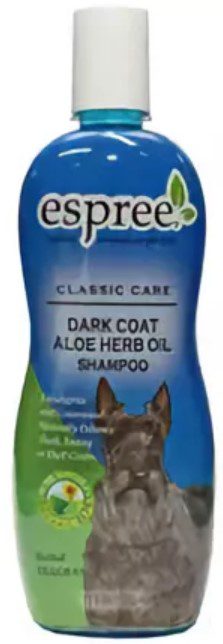
Espree launches line of products for rough-haired dogs
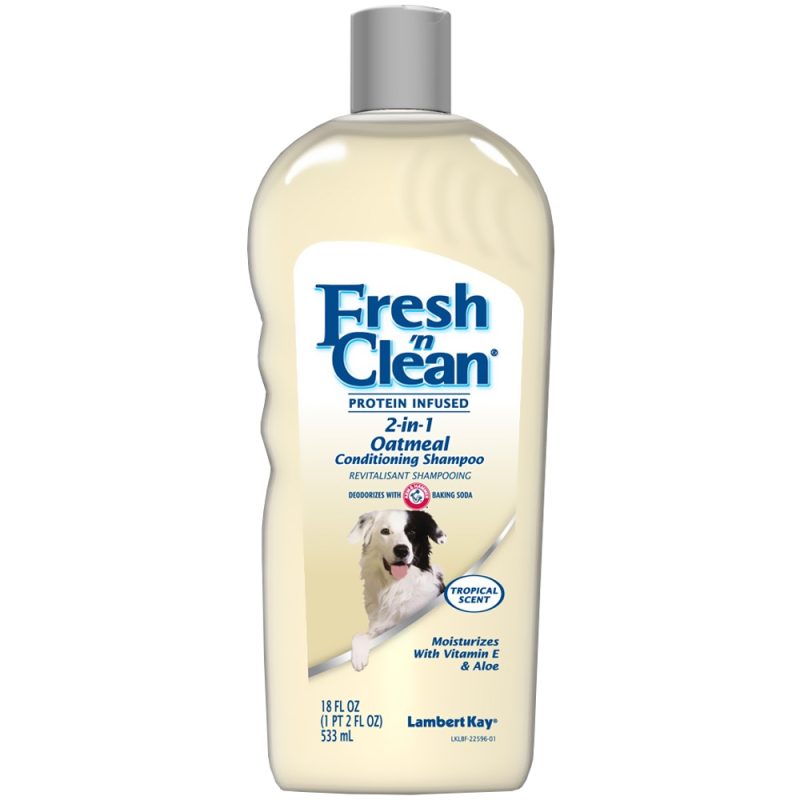
Lambert Kay is a quality Schnauzer coat cleaner.
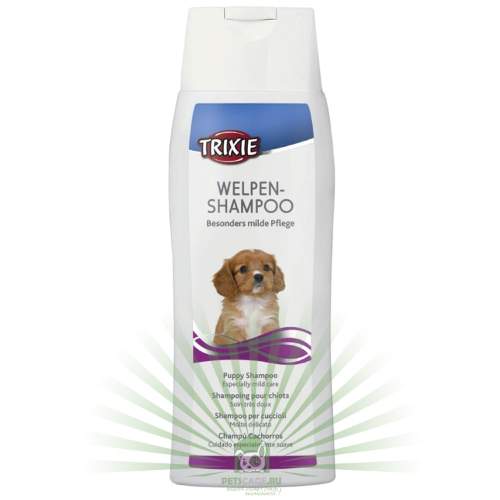
Trixie is the market leader in pet supplies

Shampoo for dogs with mink oil adds shine to the coat
Principles of proper nutrition
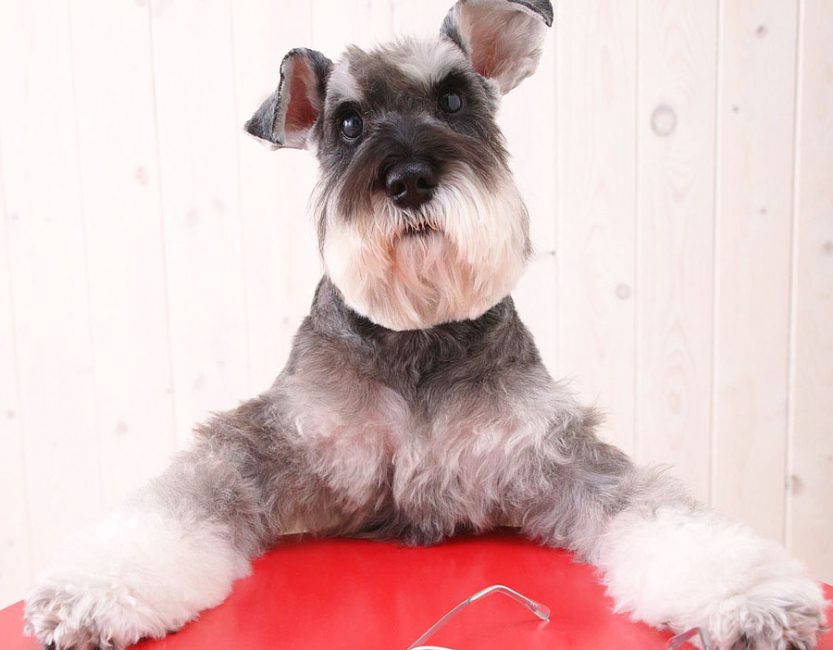
The diet of a schnauzer should be dominated by lean protein foods, as well as vegetables.
When purchasing a small zwerg at the age of 2-3 months, remember that he already has his own eating habits. Despite the fact that representatives of this breed are distinguished by an extremely strong stomach and excellent appetite, you should not drastically change his diet. For the first couple of weeks, offer your pet only familiar foods that the breeder fed him. New treats should be introduced into the diet gradually.
Until the age of 4 months, the puppy is fed 4 times a day (average portion 100-180 g). For the next 5 months, the pet needs 3 meals a day (380–400 g each). And after 9 months, it is enough for the dog to give food 2 times a day (400–450 g each).
The following foods should be present in the diet:
- offal (stomachs, beef cheeks, hearts);
- fruits (pear, apple);
- boiled sea fish;
- eggs;
- vegetables (beets, carrots, cabbage, pumpkin, tomatoes);
- porridge (oatmeal, wheat, barley);
- cottage cheese, milk, sour cream;
- meat (poultry, beef, rabbit, horse meat).
During the change of teeth, it is advisable for the zwerg to give beef bones or toys from a pressed core.
Important! Fatty foods (hard cheeses, lamb, pork, duck, etc.) are contraindicated for miniature schnauzers. Also exclude from the diet salt, sausages.
After trimming, foods that help accelerate hair growth should be introduced into the pet’s diet. For example, supplements containing seaweed, chitin shells of mollusks, salmon oil or vitamin preparations for the growth of outer hair. All of these can be purchased at pet stores.
As ready-made feeds, it is recommended to choose super-premium mixtures focused on small breeds. Popular brands today are Acana, Royal Canin, Purina.
Features of mating, the course of pregnancy and childbirth
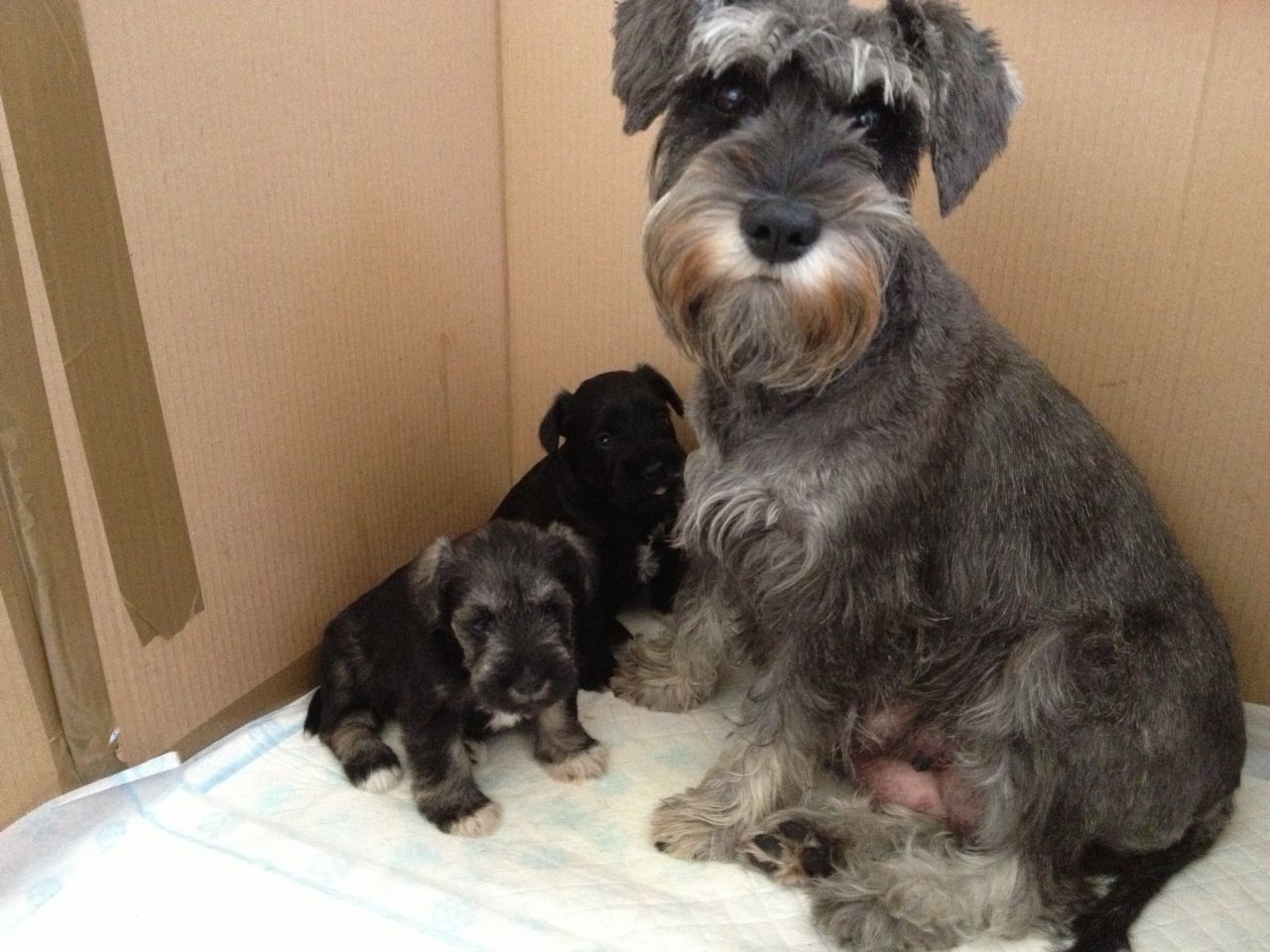
Mating a miniature schnauzer is a responsible process that requires attention to the choice of a partner and the health of the dog
Mating a miniature schnauzer is not a prerequisite for maintaining the health of a pet, so this decision is always at your discretion. If you intend to get offspring from your pet, pay attention to the following important points:
- Coat color. Today in Russia, matings between zwergschnauzers of different shades are not officially recognized. But if the mating happened unscheduled, then you should know that some combinations can be successful. For example, mating a black mini schnauzer with a black and silver will help improve the latter’s conformation. But the most unfortunate option is knitting black and “pepper and salt”. In any case, such puppies will be considered a breeding marriage.
- Pet growth. Do not forget about the breed standard. If your pet has a fairly large physique, you should not pick up the same dog for her. Compact partners with good anatomy are always preferred.
- Pedigree. For the first mating, it is better to choose a partner with common ancestors in the 2nd or 3rd generation with an excellent exterior. So you can get first-class puppies.
- Age. It is optimal to produce the first mating after reaching one and a half years, while in the third estrus. In the future, mating is carried out no more than 1 time per year. After the bitch reaches 9 years of age, mating is stopped. As an exception, an outstanding breeder with excellent health can be admitted.
A common problem when mating miniature schnauzers is the unfriendly behavior of the bitch. Quite often, even the most calm and balanced individuals show aggression during mating. Therefore, experienced breeders practice fixing the bitch during mating, as well as putting on a muzzle, which is removed only after the partners leave the “castle”.
The course of pregnancy normally lasts 63 days, but pregnancy is allowed for a period of 53-71 days. At a period of 4 weeks, you will be able to notice the first signs (the area of u5bu6bthe last ribs is slightly distributed). At week 7, the bitch’s nipples turn pink and swell, symptoms of toxicosis and food refusal may be observed. At 8 weeks, you will notice an increase in the abdomen, and at XNUMX-XNUMX weeks you can already feel the puppies moving inside the womb.
Features you should be aware of when your pet is pregnant:
- Starting from the second half of the term, the dog needs enhanced nutrition. The diet should be dominated by animal protein, minerals and vitamins. Often dog breeders give special food for pregnant dogs, for example, “Reproduction” from Royal Canin.
- If your pet is on natural feeding, you should increase the amount of meat in the diet and introduce a vitamin and mineral supplement (you can buy it at a veterinary pharmacy).
- Instead of 2 meals a day, food should be given 3-4 times a day.
Build a place for the dog where she will live with newborn puppies
Take care of the arrangement of the place for the future woman in labor. For the nest, most often they take a box or box about 70 * 110 cm in size so that the dog can lie quietly and feel comfortable. It is recommended to lay a piece of linoleum or oilcloth on the bottom, on top of which a clean cotton fabric is laid out in several layers. These can be towels, sheets, etc. The bitch needs to be introduced to such an equipped place before giving birth.
Important! Do not place the box in a draft.
So, you can determine the onset of childbirth by the following signs:
- the body temperature of the bitch drops to 37 degrees;
- the dog loses its appetite, and it can completely refuse food;
- there is a prolapse of the abdomen, which resembles a bag;
- the loop swells, thick mucous secretions appear;
- contractions appear.
You will notice the bitch’s anxiety, she does not find a place for herself, lies on her side, may whine, tremble and breathe heavily. This means that contractions have begun, which last 6-12 hours. At the end of this stage, attempts begin. You need to be close to the pet, follow the process and help if necessary.
Stock up on the following essentials:
- clean diapers (preferably ironed);
- sterilized scissors, brilliant green, thread (for cutting and tying the umbilical cord);
- a bowl for folding afterbirth;
- terry towel (may come in handy for puppy resuscitation).
Your actions are as follows:
- After the appearance of the first baby chick, it must be picked up, carefully torn off the fetal membrane, and wiped with a clean diaper.
- If the bitch has not gnawed the umbilical cord on her own, this task falls on your shoulders. Drive the blood away with your fingers in the direction of the puppy’s tummy, take the scissors and cut the umbilical cord at a distance of 2 cm.
- Then tie it with a thread and cover it with green on top.
- Place the puppy under the side of the bitch so that he begins to suck milk. Such actions contribute to the stimulation of the uterine contractions of the bitch, so subsequent babies will not have to wait long.
- Similar manipulations are performed with each puppy.
Important! If a newborn baby has no signs of breathing, it must be immediately rubbed with a terry towel.
Afterbirth, which are expelled after each puppy, must be collected in a separate container. Then they are counted. If the number does not match the number of newborn puppies, the dog must be taken to the veterinary clinic, because this indicates that there is a frozen fetus inside. Do not delay with this, your pet may die.
Caring for a bitch after giving birth is an important task for the owner. Remember that for one to two weeks (in rare cases up to a month), she may experience spotting from the loop. This is a normal natural phenomenon. However, if this discharge becomes purulent, smells bad, or there are many blood clots, the dog should be taken to the veterinarian immediately.
After giving birth, the pet will have indigestion, so she will need a special sparing diet. Give her low-fat chicken broth with chunks of meat. If your dog eats food, do not change it, but just give it a little soaked in water.
To avoid inflammation of the mammary glands (mastitis), inspect your pet and her nipples daily. Where they look overcrowded, put in the strongest puppies. They will quickly suck out the milk, and it will not be able to stagnate and lead to an inflammatory process. If the puppies are not up to the task, give the dog a light massage of the glands.
Raising and training a miniature schnauzer

Miniature Schnauzers are highly trainable.
A big misconception among inexperienced dog breeders is the attitude towards the miniature schnauzer as a decorative small dog. Despite its size, it is a strong and hardy pet with excellent working qualities. It is necessary to start training the zwerg from the age of 3 months. The main thing is to show the dog that training is more of an entertaining game than the monotonous execution of commands.
At the age of up to 6 months, the miniature schnauzer is brought up extremely simply and quickly. The owner must teach the pet the maximum number of simple skills – calling, shrinking, jumping over small barriers, laying, following, moving near without a leash. New commands need to be introduced into the training course gradually, after the dog has mastered the previous ones well.
To develop interest in the process, activity and courage in a small schnauzer, sometimes give in to him during exercises, imitating his victory. For example, let your pet periodically pull a stick or rope out of your hands. But don’t overuse it.
Team Fu! – prohibition of any action and requires strictness. Say it without shouting, but firmly. Upon hearing this command, the pet must stop the action immediately. You need to accustom to it according to the method of “carrot and stick”. For perfect performance, reward the zwerg with a treat, and for ignoring – with a pull. Do not use physical punishment. Recall that the miniature schnauzer is a smart and reasonable dog. Your task is to make her understand what is good and what is bad, and not pointlessly beat, causing loss and fear.
At the age of 8-10 months, you can give your pet for OKD (general training course). But besides this, do not forget about the joint visit to the sports ground and walks. The dog will only be happy to follow standard commands and receive praise from his beloved owner.
Pet health
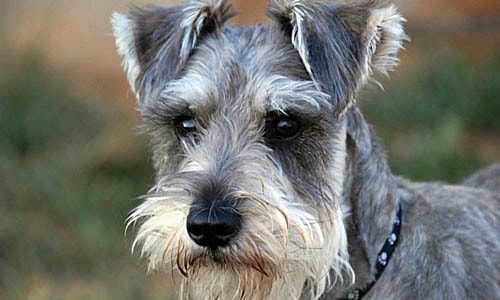
Diseases can appear due to improper care
One of the indisputable advantages of the breed is its health. Activity and cheerful temperament contribute to the fact that the miniature schnauzer rarely gets sick. However, breed ailments can still manifest themselves, most often with improper care of the pet.
The main diseases of miniature schnauzers:
- food allergy (often observed with a chaotic alternation of natural food and feed);
- limopa (benign formation in the subcutaneous fat layer);
- melanoma (malignant tumor);
- hypothyroidism (thyroid hormone deficiency);
- epilepsy;
- glaucoma;
- cataract;
- progressive retinal degeneration (hereditary disease);
- cryptochism (undescended testicles into the scrotum);
- pancreatitis;
- urolithiasis disease;
- pulmonary stenosis (hereditary disease).
The most dangerous disease of the miniature schnauzer is considered to be retinal atrophy. Such a pathology begins to manifest itself quite early, the first signs will be noticeable already at the age of six months. Gradually losing sight, the pet is completely blind by 2-3 years. Therefore, carefully study the documents from the breeder when buying a puppy.
To protect your zwerg from the appearance of most diseases, it is necessary to carry out timely vaccination. The scheme is as follows:
- the first vaccination is done at 2 months;
- the second – after 3 weeks;
- the third vaccine is given at 1 year of age.
Remember that a week before vaccination, the pet needs to get rid of worms. The drug and dosage are usually prescribed by a veterinarian. After the procedure, try to walk the dog in isolation from other animals for 2 weeks. Do not be alarmed if your pet has a short-term lethargy – this is normal. But if you notice frequent breathing, swelling on the mucous membranes, then refer to the windinar. This could be a negative reaction to the vaccine.
Nickname choice
Choosing a nickname is an important but enjoyable process.
The miniature schnauzer is a small, friendly, intelligent, active dog that is not suitable for formidable nicknames. When choosing a name for your pet, be guided by the convenience of pronunciation and inner flair, which will certainly tell you exactly how your new family member should be called.
Among the most suitable breed nicknames for males are the following: Arron, Axel, Avdey, Amur, Ajax, Baxter, Barry, Bradley, Bucks, Benedict, Bloom, Bart, Bernie, Bruce, Bronx, Bob, Vincent, Venya, Hamlet, Hector , Gunther, Helmut, Harry, Garvosh, Gwen, Griffin, Danko, Dantes, Dexter, Den, Jackson, Drake, Jonik, Joker, Jerome, Zhofrey, Zhorzhik, Zephyr, Zolf, Zando, Kaiser, Carter, Quentin, Casper, Cooper , Klaus, Cadet, Camelot, Lars, Leon, Lingo, Loki, Loyd, Max, Merlin, Mars, Marcus, Marvin, Marcel, Nico, Oliver, Oji, Oscar, Romeo, Roy, Remy, Richard, Rufus, Scout, Simon , Tim, Toby, Topaz, Tinker, Phoenix, Flash, Harley, Edwin.
For a miniature zwerg girl, you can choose one of the following nicknames: Iris, Alexa, Alma, Allegra, Angelina, Ariella, Beta, Baby, Briana, Vanessa, Vita, Volta, Viola, Gabrielle, Greta, Gerda, Jennifer, Dara, Josie, Jessie , Jasmine, Giselle, Isabella, Kara, Kelly, Kira, Courtney, Lyra, Leah, Maris, Martina, Milena, Mira, Michelle, Nika, Pixie, Rachelle, Riana, Samantha, Selina, Scarlet, Sophie, Tequila, Tilda, Terra , Tiffany, Flora, Frida, Helga, Chloe, Evie, Eris, Yasmin.
Owner feedback
My zwerg is now five months old. There are no problems with maintenance, it seems. smart, she only goes to the toilet outside. knows the commands “to me”, “sit”, “give a paw”, “place”, “bring a toy”. feature – very active, rarely sleeps and constantly pestering everyone to play with her. one does not like to be. always where people are. but when you leave home alone, it doesn’t seem to whine. barks heart-rendingly when the neighbors pass by our door, but not barking at all, barking only on business. the only thing that annoys me is following me on my heels, tk. I am her “master mistress”. those. if I am in one room for a long time, and she is in another, she will definitely come to me and lie down next to me. sleeps next to me. and another feature – very friendly and communicative – an unfamiliar person can be licked, but I’m going to start training her soon. I hope this moment will be corrected, because. tsvergs should not be like that, they are guards, after all.
Ira
I have a Zwerg Phil. The best, kindest understands everything. This is my first dog and I have no regrets about getting him. There are no cons. Everyone writes that the minus is wool. On the contrary! He doesn’t shed. This is a huge plus. It just needs to be trained. Without it in any way, as well as with another dog
a guest
If you want to get a zwerg, then trimming should scare you the least. Trimming, only, replaces seasonal molting. If the coat is mature, then this procedure is not painful. Dogs tolerate it very calmly (if, of course, they are normally brought up). Trimming is carried out 2-4 times a year, depending on the quality of the dog’s coat. After trimming for about four months, the dog does not shed at all, then the hair begins to fall out, but as a rule, if the dog catches on something, it rubs its back against a carpet or sofa, etc.
Camilla
The miniature schnauzer is a miniature watchman who is ready to give his master all the love and devotion. He will become an equal member of the family for those who are ready to pay a lot of attention to their pet. Representatives of this breed are distinguished by good health, balance, goodwill and observation. Thanks to their sonorous barking and readiness to rush into battle with the enemy, they become good watchmen. The miniature schnauzer is equally well suited for both an experienced dog breeder and a beginner.



